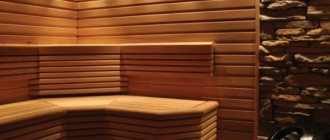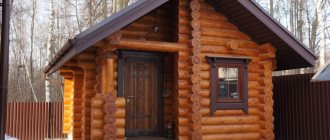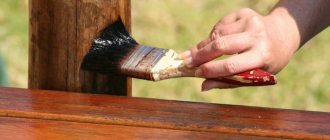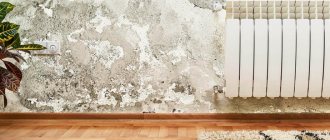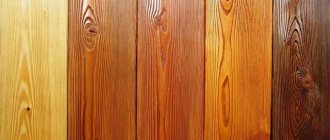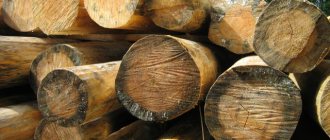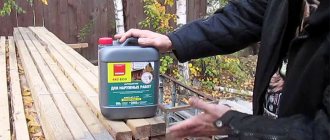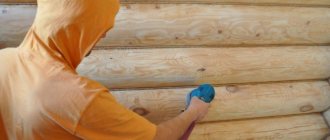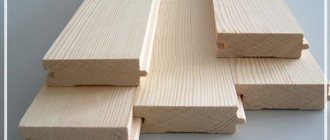Flaxseed oil is traditionally used to treat houses and wood products. Undoubtedly, linseed oil for wood is a valuable product that best ensures the safety and protection of wood material. The classic version involves using the product in its pure form. However, despite the obvious advantages, the traditional product has certain disadvantages that cause inconvenience in its use and limit its scope of use.
Modern industry offers many professional impregnations based on linseed oil, in which all the advantages of the product are most clearly manifested and at the same time its disadvantages are completely eliminated. In this review, we will look at both of these products and find out what effect their use has on wood.
Features of oil impregnation
During the construction of wooden buildings, many special materials are used to ensure the preservation of wood for a long time. One of such protective coatings that reliably protects its structure from moisture is linen impregnation. The origin of this processing method dates back to ancient times, when inexpensive linseed oil was widely used as a simple protective composition. With its help, techniques were mastered for preserving from destruction not only the prefabricated elements of wooden buildings, but also various wood products (including furniture, carved decorations and dishes).
Flaxseed oil belongs to the category of natural substances made from the seeds of this product by cold pressing (at a temperature of no more than 50°C). With a decrease in the temperature at which this protective substance is produced, its quality increases noticeably, which is reflected in an increase in the depth of impregnation.
Features of processing wood blanks using linseed oil include:
- the depth of its penetration into the structure of the material is about 2 mm, which is quite enough to obtain a reliable protective layer;
- the resulting coating, protecting against moisture entering the wood structure, is not a barrier to air (the wood continues to “breathe”);
- being a natural antiseptic, this material provides reliable protection against the formation of fungi, and also protects it from small insects and mold;
- special impregnation helps protect the surface of the treated material from sudden temperature fluctuations and reduces the likelihood of cracks;
- and, finally, such processing gives the wood structure a rather attractive appearance (due to the appearance of a shade that is pleasant to the eye).
Also keep in mind that impregnation of products and materials with linseed oil is not accompanied by the formation of a dense film , which is typical for many other insulating compounds. In addition, the coating obtained after processing is absolutely environmentally friendly and does not cause any harm to human health.
DIY painting mistakes
Often, unprofessional craftsmen, having received superficial information from the Internet about oil application technology, perform the work themselves. This inevitably leads to errors in work, which affect the quality of painting.
Below are typical mistakes that non-professionals often make:
- Violation of technology. Despite the fact that in general the process of applying different types of oil is the same, each impregnation has its own unique composition, which introduces certain nuances into the rules for treating wood with this product.
- Insufficient surface preparation. Many people do not pay due attention to the preparatory work, do not clean off the old coating well, do poor-quality sanding, and leave uneven spots and cracks. As a result, after applying the oil, all defects come out, which greatly deteriorate the appearance of the coating.
- Carrying out work at high wood humidity. Humidity is a very important indicator; if you apply oil to undried wood, the impregnation will not be able to penetrate into the deeper layers and provide full protection.
- Delays or rushed work. Unfortunately, this mistake is often made by contracting organizations. Compliance with the timing when applying the coating is very important. The first layer must sufficiently saturate the surface before applying the next one. It is also important to apply a second coat before the surface becomes covered with dust and dirt. After all, wood undergoes deep cleaning before painting and should not be left unprotected for a long time. Violation of deadlines under a construction contract may cause a violation of painting technology.
To avoid these and similar mistakes, contact professionals. has more than ten years of experience in finishing and processing wooden houses. Our company pays special attention to quality; all work is carried out under strict control by the technical supervision department.
We are official dealers of well-known manufacturers of professional products based on linseed oil Osmo, Remmers, GNature, Biofa, Wooden Wood, Ramsauer, thanks to which we can provide special conditions for our customers. When ordering home treatment with oils from these manufacturers, the cost of the products is calculated at the wholesale price.
Our partner is also legal. This is a team of specialists focused on disputes in the construction industry. We always recommend the legal services of this company to our clients who have fallen into the hands of charlatan builders. If suddenly your choice is not our company, then before making payments and making advances to the contractor, conduct a legal analysis of the terms of the contract . This will help save you hundreds of thousands of rubles.
We provide services in Moscow and neighboring regions, to leave your request, contact us using the coordinates on the “Contacts” page.
Calculate the cost of painting and insulating your home right now
Select types of work:
Select materials:
Where to get oil?
The question most often asked about processing with linseed oil is: where to get it? What, just smear some food stuff from the store? In short, yes, it can be straight food. Just in case, you can look on the Internet to see if there is a plant in your region. Sometimes you can purchase substandard linseed oil from the factory at a discount. But if there is no plant, don’t despair. Go to the nearest wholesale center and buy a box of linseed oil in maximum packaging. As the box runs out, you can easily determine whether you will need to buy more and how much. It makes no sense to write down the approximate consumption, since it strongly depends on the moisture content of the wood: for dry profiled timber it will take less oil, but for wet rounding you will need a lot of lime.
Linseed oil for wood impregnation
To produce technical linseed oil, curly flax is grown; the seeds of this plant contain up to 50% of oil substances. Flaxseed oil is a natural waterproof polymer; the polymerization process is activated by atmospheric oxygen; the product is stored in a closed metal container.
The requirements for linseed oil are standardized according to GOST 5791-81, the grade depends on the degree of purification. The purified (refined) product has a transparent golden-orange color, the impurity content does not exceed 0.05%, the unrefined product is darker in color, the presence of sediment up to 0.15% of the volume is allowed. It comes to the retail chain in metal and plastic containers with a capacity of 3 to 50 liters, the shelf life in plastic is limited, you need to pay attention to the packaging date.
Experts recommend using cheaper, unrefined linseed oil for impregnation of the log house, which has a shorter polymerization time; pine turpentine is used as a diluent. Professional impregnating compositions are made from the refined product.
Oil processing technology
There are several approaches to the protective treatment of wood using linseed oil, which involve:
- immersing carefully prepared workpieces in a boiling impregnating mixture;
- surface preparation followed by treatment with oil heated to the required temperature;
- so-called “vacuum” impregnation.
The first of these methods is usually used when it is necessary to process small-sized wood blanks (most often these are decorative handicrafts). When preparing the material for processing the walls of a building under construction, I recommend using a more simple-to-implement surface impregnation with a mixture heated to the required temperature. To do this, you just need to bring the impregnating composition itself to the desired condition, and then apply it to wooden surfaces using a regular paint brush.
To implement the last of these methods, you will need a vacuum pump, through which air is removed from the pores of the wood. After “squeezing out” the air layer with this tool, its place is taken by a layer of linseed oil, during the polymerization of which the surface of the timber acquires the required structure.
The high cost of the pump, as well as the one-time nature of vacuum procedures, make it pointless to purchase it for permanent use.
I advise you to agree on the temporary use of this expensive tool with one of your friends or rent it from professionals for the period of processing.
Popular projects on our website
Project a1
Project a2
Project a3
Our website presents a number of log house projects, for example: Or you can see all prices for log houses. You can calculate the house or bathhouse you need with maximum accuracy using our log house cost calculator. To order and buy a log house, call:
- Vologda
- Moscow,
Comments
No comments yet.
Preparatory activities and procedure for covering wood
Regardless of the chosen method of processing wood products, before starting impregnation, they should be thoroughly prepared for this procedure. To do this you will need to take the following steps:
- First of all, each protected wooden part or individual workpiece must be cleaned of dirt and thoroughly dried.
- If there is an old coating on the wood, it must be removed using sandpaper of a suitable grain size.
- If re-impregnation is being done, to improve its penetration into the wood structure on the already treated surface, I advise you to go through the same sandpaper again
- Mix the linseed oil thoroughly before starting the impregnation; At this point the preparatory stage can be considered complete.
Upon completion of all of the above operations, you can proceed to the main operating procedures. When carrying out direct protective work, well-mixed linseed oil is first applied in two layers, after which it should be allowed to absorb well and dry for a certain time. Try to complete all necessary operations within an hour, after which remove excess impregnating composition with a previously prepared soft rag.
Important! When applying impregnation directly, try to move the brush in the direction of clearly visible wood fibers.
A surface treated with high-quality oil under normal conditions dries for at least a week, after which you can proceed to polishing it with natural wax.
After final processing, the surface of the wood product acquires a pleasant natural shade, on which the features of its texture are clearly visible. At the same time, its resistance to mechanical stress, as well as to ultraviolet radiation, increases. I advise all their owners to carry out this treatment of the external surfaces of wooden buildings annually.
How to treat a log house with linseed oil yourself
It is necessary to calculate the required amount of impregnating material and buy the entire batch at once; it is not recommended to use oil from different manufacturers; batches may differ in color and viscosity; the product has an expiration date. The processing of wooden walls is divided into stages:
- Surface preparation. Linseed oil should be applied to a dry, prepared surface; the moisture content of the wood should not exceed 15%. The walls of a newly built building are sanded; when updating the old coating, the surface layer is removed. After treatment, the surface is cleaned of dust; this is best done using a jet of compressed air.
- Priming and antiseptic. Large cracks and wood defects are primed; for this it is better to use an alkyd primer tinted to match the color of the wood. Before impregnation, the surface is wiped with white spirit. Experts recommend treating the lower crowns of the log house with an antiseptic; for this you can use a solution of boric acid and rock salt.
- Application of impregnation. Flaxseed oil is applied with a brush with stiff synthetic bristles or a felt roller; the treatment of the log house begins from the top crown; the composition is applied only along the fibers and is evenly distributed over the surface. To prevent the formation of oil stains, after 20-30 minutes the unabsorbed impregnation is removed from the surface with a soft rag. A new layer is applied after the previous one has dried. The polymerization process takes up to 72 hours; when carrying out facade work in the warm season and in dry sunny weather, the drying time is reduced by 1.5-2 times. When treating walls indoors, it is necessary to ensure air circulation.
- Finishing processing. The treated surface is sanded with felt pads, and a layer of melted wax is applied to the surface to protect it from solar ultraviolet radiation. The wax coating is polished with felt or a woolen rag; after this treatment, the wood acquires an attractive appearance with a pronounced texture.
Industrial impregnations
The domestic market offers a wide range of special impregnating agents made on the basis of linseed oil. Special impregnating primers intended for treating the internal and external surfaces of buildings are in high demand among consumers. This wood primer dries quickly enough (no more than 4 hours) and can be used for any type of wood.
I advise everyone who wants to paint their home with natural dyes to purchase painting material from the “NATURA” brand, which, in addition to linseed oil, also contains special mineral pigments. In addition, manufacturers have developed special paste-like pigment dyes, which, when mixed with linseed oil, form the composition of the required shade.
You can familiarize yourself with the procedure for preparing it and applying it to the surfaces to be treated in the instructions supplied with the paste. If you haven’t had time to treat a wooden house, read the article “How to get rid of mold“
Other types of impregnations: what to choose?
To stabilize the condition of wood and improve its user characteristics, other oils and complex compositions with oil are used. Sometimes the choice of how to process a log house is influenced by the availability of ingredients. 1) Other oils They use drying oil, which is already partially polymerized oil - nut, linseed, due to heat treatment. Further polymerization occurs in air and faster than when using raw, non-thermally treated oil. Regular oil is absorbed slowly, it takes several weeks to completely polymerize, and it takes more than a month to apply several layers. Heat-treated drying oil is absorbed immediately, after a day it dries with the appearance of a film, 2-5 days after impregnation, the treated surface becomes inert and can be covered with a new layer. You need to purchase drying oil in special construction stores. It is dangerous to produce heat-treated oil at home by simmering it over a fire. Some manufacturers have switched to producing drying oil using safe chemical drying. In stores you can find drying oil oxol, which is attractive at a low price. It is made from sunflower oil, but it does not dry out, and over time it turns bitter and darkens. In order not to spoil the log house, it is better to choose other, more expensive than sunflower oils: - hemp, the effect of which is similar to that obtained when using flaxseed. To reduce the cost of impregnation (1 liter - 600 rubles), they are looking for a cheaper substance obtained from technical varieties of the plant; - tung, its purchase will cost slightly less (1 liter - 550 rubles). In terms of user characteristics, it is comparable to linen; – other natural oils with the property of polymerizing – obtained from poppy seeds, nuts, white acacia, pine and spruce seeds. 2) Oil compositions To preserve wood - introducing substances into its pores that create a protective layer, compositions based on oils with wax, tar, and turpentine are used. Thus, products are used whose main component is linseed oil (40-70%), and additives are wax, turpentine, rosin. Flaxseed oil (50%) is mixed with other oils - tung (15%), orange (10%), and wax, rosin. Beeswax and carnauba wax are used, which improves the user properties of cheap waxes. A composition is used that is prepared by diluting high-quality drying oil in a ratio of 7:3 with turpentine. Apply it warm, heating to 50-60°C. The log house can be given the desired shade by adding pigments to the mixture. 3) Waxing If tar and turpentine are toxic and can provoke allergic reactions, then mixtures with wax are safe for health and suitable for external and internal processing of log houses. Remaining on the surface and penetrating the wood structure, wax provides good moisture insulation. 4) Compositions with synthetic components Varnishes and paints with artificially obtained ingredients in the composition harden when dry. Impregnation of wood with such means is inferior in all qualitative characteristics to treatment with compositions with natural ingredients. Its only advantage is quick drying. Those who succumb to the temptation to quickly treat a log house with impregnation with non-natural components are faced with the downside of such a solution - constant restoration work.
